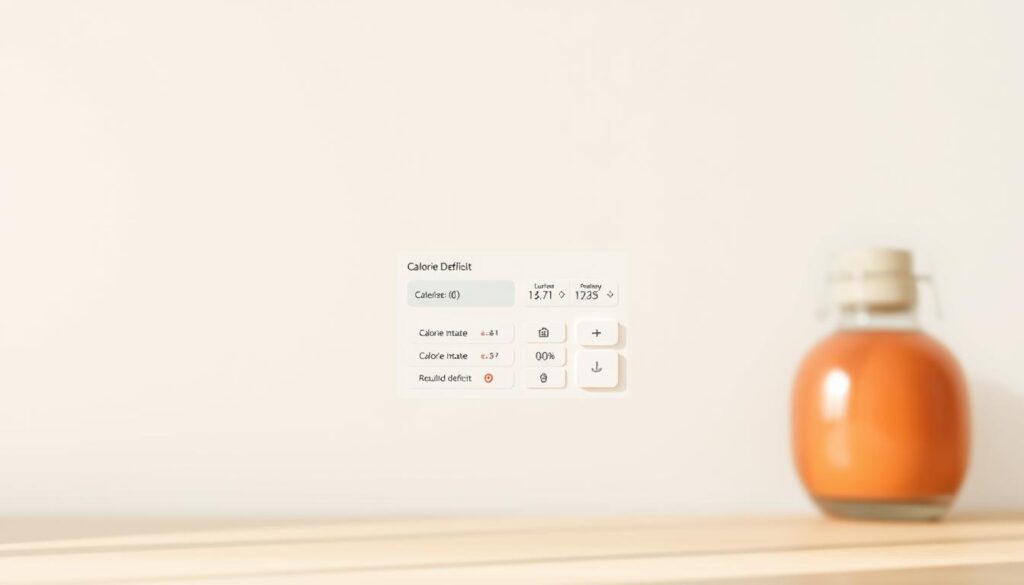As Michelle Obama once said, “You can’t just talk about it, you have to make it happen.” Achieving a healthy weight loss is about making informed decisions regarding your daily calories intake and expenditure.
A calorie deficit occurs when you consume fewer calories than your body burns, leading to weight loss. However, cutting too many calories can lead to health issues and excessive hunger.
We’ll explore the science behind creating a sustainable deficit for weight loss without constant hunger pangs, and discuss strategies for a healthy diet and food choices that support long-term health and weight management.
Key Takeaways
- Understand the concept of calorie deficit and its role in weight loss.
- Learn how to create a sustainable deficit for healthy weight loss.
- Discover strategies for managing hunger while maintaining a calorie deficit.
- Explore the importance of a balanced diet and food choices.
- Find out how to support long-term health and weight management.
Understanding Calorie Deficit and Weight Loss
A calorie deficit is fundamental to weight loss, but it’s not just about eating less. When we talk about losing weight, we’re essentially discussing creating a situation where our body burns more calories than it consumes.
What Is a Calorie Deficit?
A calorie deficit occurs when the body expends more energy than it takes in, prompting it to use stored energy sources, such as fat, for fuel. This state is crucial for weight loss as it signifies that the body is utilizing its stored fat for energy.
The concept is straightforward: consume fewer calories than your body burns, and you’ll lose weight. However, the body’s response to a calorie deficit is complex, involving various physiological and hormonal changes.
Why Hunger Makes Weight Loss Difficult
The body fights against weight loss due to a principle known as homeostasis, where it strives to maintain its current state, including weight. This resistance is partly why dieting can be so challenging and why hunger often intensifies when in a calorie deficit.
Several factors contribute to this increased hunger, including hormonal changes. Hormones like ghrelin and leptin play significant roles in regulating appetite. Ghrelin stimulates appetite, while leptin suppresses it. When in a calorie deficit, the body may produce more ghrelin and less leptin, making us feel hungrier.
| Hormone | Function | Effect During Calorie Deficit |
|---|---|---|
| Ghrelin | Stimulates appetite | Increased production |
| Leptin | Suppresses appetite | Decreased production |
How to Calculate Your Calorie Deficit
The first step in losing weight is figuring out your daily calorie deficit. To do this, you need to understand your maintenance calories, which is the number of calories your body needs to function at rest.
Determining Your Maintenance Calories
Your maintenance calories are influenced by factors such as age, sex, weight, and activity level. Knowing this number helps you set a realistic calorie deficit goal. A calorie deficit occurs when you consume fewer calories than your body burns, resulting in weight loss.
Using the BMR Formula Method
One way to estimate your maintenance calories is by using the Basal Metabolic Rate (BMR) formula. The BMR formula calculates your resting metabolic rate, and then you can adjust it based on your activity level to find your daily calorie needs. For example, if your BMR is 1,800 calories and you’re moderately active, your daily maintenance calories might be around 2,500 calories per day.
The 10-Day Tracking Method
For a more precise number, track your calorie intake and weight for 10 days while maintaining the same level of daily activity. You can use a calorie tracking app to monitor your calories and weigh yourself daily. Divide the total number of calories you consumed for 10 days by 10 to find your average daily calorie intake. Then, subtract 500 calories from this number to determine your new daily intake goal for weight loss, creating a calorie deficit.
Creating a Sustainable Calorie Deficit
Sustainable weight loss is not just about cutting calories, but about creating a deficit that works for you in the long term. When aiming for weight loss, it’s crucial to understand that a calorie deficit affects your metabolism. Prolonged calorie restriction can slow down your metabolic rate to adapt to the new calorie intake, making weight loss more challenging over time.
Finding Your Ideal Deficit Range
To create a sustainable calorie deficit, you need to determine your ideal deficit range. Acalorie deficitthat is too extreme can lead to health issues, including nutrient deficiencies and decreased metabolism. A moderate deficit, on the other hand, allows for a more gradual weight loss, which is often more sustainable. For most individuals, a daily calorie deficit of 500 to 1000 calories is recommended, as it promotes a weight loss of 1-2 pounds per week.
Why Extreme Deficits Backfire
Extreme calorie deficits can have adverse effects on your body. As noted by health experts, “Very low-calorie diets can lead to nutrient deficiencies, muscle loss, and a higher risk of gallstones” (source). Moreover, severe calorie restriction can trigger increased hunger hormones, making it harder to stick to your diet. A more balanced approach to calorie deficit is essential for long-term success.
| Calorie Deficit Range | Expected Weight Loss | Sustainability |
|---|---|---|
| 500-1000 calories/day | 1-2 pounds/week | High |
| 1000-1500 calories/day | 2-3 pounds/week | Moderate |
| >1500 calories/day | More than 3 pounds/week | Low |
How to Calculate Calorie Deficit Without Hunger
Calculating a calorie deficit that works without leaving you hungry is crucial for successful weight loss. We help our clients achieve this by setting their deficit within a caloric window, rather than targeting a specific daily calorie number.
The “Eat More Food” Approach
Many of our clients initially believe that the lowest calorie number will yield the quickest results. However, we encourage them to eat more food within their caloric window. This window is typically between their Basal Metabolic Rate (70% of their metabolism) and Goal Body Weight in LBS x 12. By doing so, they can maintain a calorie deficit while still feeling satisfied.
As “You don’t have to eat less, you just have to eat differently.” This approach focuses on nutrient-dense foods that provide satiety and support overall health.
Setting a Caloric Window vs. Strict Numbers
Using a caloric window provides flexibility while maintaining an overall calorie deficit. Daily calorie needs naturally fluctuate based on factors like activity levels and hunger. By tracking weekly averages rather than daily targets, our clients can adjust their intake within their window without feeling restricted.
This approach reduces stress and improves long-term adherence to a deficit. As shown in the image below, visualizing a caloric window can help in understanding the flexibility it offers.
By adopting this strategy, individuals can achieve a sustainable calorie deficit without feeling hungry or deprived.
High-Volume Foods That Keep You Full
To achieve a calorie deficit without feeling hungry, it’s essential to focus on high-volume foods that provide a feeling of fullness while keeping calorie intake in check.
Protein: The Weight Loss Superfood
Protein is a crucial nutrient for weight loss, as it helps build and repair muscles while keeping you full. Incorporating high protein foods like lean meats, fish, and eggs into your diet can significantly aid in your weight loss journey.
Some of the best high protein foods for weight loss include chicken breast, salmon, and Greek yogurt. These foods not only provide a high amount of protein but are also rich in other essential nutrients.
Fiber-Rich Carbohydrates
Fiber-rich carbohydrates are another category of high-volume foods that can help you feel full without consuming too many calories. Foods like whole grains, fruits, and vegetables are not only rich in fiber but also provide essential vitamins and minerals.
Examples include oatmeal with fruits, whole-grain bread with avocado, and a variety of colorful vegetables. These foods are not only filling but also support overall health and energy levels.
Smart Fat Choices
While it’s true that fats carry a significant amount of calories (9kcal per gram), they are essential for our health, playing a critical role in hormone production and the absorption of vitamins. The key is to make smart fat choices that provide maximum benefit with minimal calories.
Healthy sources of fats include nuts, seeds, avocados, and olive oil. These foods are not only rich in healthy fats but also provide a feeling of fullness, making it easier to maintain a calorie deficit.
By incorporating these high-volume foods into your diet, you can achieve a calorie deficit without feeling deprived or hungry, making your weight loss journey more sustainable and successful.
Meal Strategies to Minimize Hunger
Minimizing hunger while on a calorie deficit involves more than just eating less; it requires a strategic approach to meal timing and composition. By understanding how to optimize meal frequency and hydration, individuals can better manage their hunger and achieve their weight loss goals.
Meal Timing and Frequency
Spacing out meals and snacks can help maintain stable energy levels and reduce hunger. Eating more frequently, but in smaller portions, can also help control hunger by keeping the body satisfied between meals. For instance, having three main meals and two to three snacks in between can be an effective strategy for some individuals.
It’s also important to listen to your body and adjust your meal frequency based on your personal needs and activity level. Some people may find that eating more frequently helps them stay full, while others may prefer fewer, more substantial meals.
Hydration and Appetite Control
Staying hydrated is crucial for appetite control, as thirst is often mistaken for hunger. Drinking water throughout the day can help reduce unnecessary snacking and support overall weight loss efforts. Sparkling water, in particular, can be a helpful tool for those looking for a low-calorie alternative to plain water.
Drinking water before meals can also help reduce overall calorie intake by promoting feelings of fullness. Aim to drink at least eight glasses of water per day, and adjust according to your activity level and climate. Incorporating zero-calorie beverages like sparkling water can make it easier to meet your hydration needs without consuming excess calories.
Exercise’s Role in Your Calorie Deficit
Incorporating physical activity into your daily routine can significantly impact your ability to maintain a calorie deficit. Exercise not only burns calories but also enhances your overall weight loss experience by improving metabolism and increasing energy levels.
Combining Diet and Activity for Best Results
To achieve the best results, it’s essential to combine a calorie-controlled diet with regular physical activity. This synergy helps in creating a more significant calorie deficit while preserving muscle mass. We recommend at least 150 minutes of moderate-intensity exercise per week, alongside strength training exercises to boost your metabolism.
Types of Exercise for Weight Management
Different types of exercise can be employed for effective weight management. These include cardio exercises like brisk walking or jogging, strength training to build muscle, and high-intensity interval training (HIIT) for efficient calorie burn. Incorporating muscle-strengthening activity at least two days a week can help prioritize the loss of body fat over muscle mass.
| Exercise Type | Description | Benefits |
|---|---|---|
| Cardio | Brisk walking, jogging, cycling | Burns calories, improves heart health |
| Strength Training | Weight lifting, resistance bands | Builds muscle, boosts metabolism |
| HIIT | High-intensity interval training | Efficient calorie burn, improves insulin sensitivity |
Maintaining Your Results for Long-Term Success
As we reach our goal weight, the real challenge begins: maintaining our results for long-term success. A prolonged calorie deficit can affect our metabolism, potentially slowing it down to match our new calorie intake. To avoid health issues associated with insufficient nutrients, it’s crucial to aim for a weight loss of no more than 1-2 lbs per week.
To maintain our weight loss, we need to transition from active weight loss to weight maintenance. This involves gradually increasing our calories as we approach our goal weight. We’ll need to determine our new maintenance calorie level and continue monitoring and adjusting as necessary.
Strategies such as reverse dieting can be helpful, and it’s essential to maintain healthy habits without a strict focus on deficit. By adopting a sustainable lifestyle, we can support our new weight without constant hunger and set new health and fitness goals beyond weight loss.



